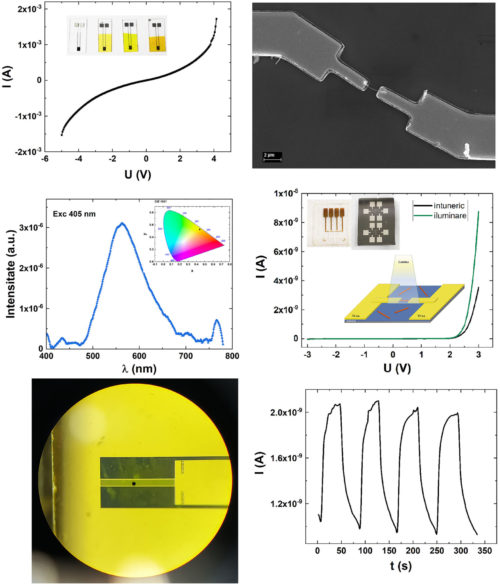Coaxial heterojunction nanowires based on ZnO and ZnSe for applications in flexible light emitting diodes
Project Director: Dr. Andreea COSTAS
Project ID: PN-III-P2-2.1-PED-2021-3984
Project leader: Dr. Andreea Costas
Project type: National
Project Program: PED
Funded by: Romanian National Authority for Scientific Research, UEFISCDI
Contractor: National Institute of Materials Physics
Dr. Andreea Costas - project leader
Dr. Ionut Enculescu
Dr. Nicoleta Preda
Dr. Monica Enculescu
Dr. Corina Ciobotaru
Dr. Mihaela Beregoi
Dr. Andrei Kuncser
Dr. Mihaela Bunea
Drd. Melania Onea
Nowadays flexible optoelectronic devices have a significant impact in many areas of research. Particularly, in the last years, flexible light emitting diodes (LEDs) focused the attention of the researchers, representing an energy efficient lighting technology due to their substantial role in reducing the global energy consumption, making them the perfect candidates for street lighting in Smart Cities. Compared to the conventional light sources, flexible LEDs present a series of advantages, like flexibility, lumen efficiency, low power consumption, long life time, controllable emission properties and the possibility to use wavelengths from ultraviolet to infrared. Such features recommend LED’s for applications in rollable displays, wearable intelligent electronics, light sources, sensors, optical fibers, digital displays, traffic lights, communications, medical treatments, etc. Thus, LED devices have become very important from scientific and socio-economic point of view. In this context, the scope of the project is the development proof-of-concept energy efficient flexible light emitting diodes with low power consumption and improved light extraction efficiency, the LEDs being based on vertically aligned coaxial ZnO-ZnSe heterojunction nanowires arrays and on single coaxial ZnO-ZnSe heterojunction nanowires. The coaxial ZnO-ZnSe heterojunction nanowire arrays will be prepared using Zn foils and Si/SiO2 wafers patterned with specific geometries as substrates, combining thermal oxidation in air with RF magnetron sputtering, two simple and low cost techniques. Fabricating flexible and nanoscale LEDs based on coaxial ZnO-ZnSe nanowires, will provide new insights in the field of light emitting diodes, expanding the possibilities for their implementation in applications such as rollable displays, street lighting and wearable intelligent electronics, energy efficient devices.
The objective of the third stage of the project - Fabrication of efficient LEDs based on single coaxial ZnO-ZnSe heterojunction nanowires: Activity 3.1 Contacting single coaxial ZnO-ZnSe heterojunction nanowires using EBL and thin film deposition techniques; Activity 3.2 Investigating the morphological and compositional properties of the LEDs based on single coaxial ZnO-ZnSe heterojunction nanowires; Activity 3.4 Investigating the optoelectronic properties of the LED’s based on single coaxial ZnO-ZnSe heterojunction nanowires and put in evidence the influence of the substrate used in the preparation of the ZnO nanowire arrays and of the ZnSe shell thickness on the LED’s performances; Activity 3.4 Dissemination of results by presentation of the scientific results to general public including possible investors, at 2 international conferences, at 2 national innovation events, by publishing 2 article in ISI indexed journals with a high impact factor (impact factor > 4) and by making 1 patent application at the state office for inventions and trademarks (OSIM). Thus, optoelectronic devices based on single core-shell ZnO-ZnSe nanowires were fabricated by contacting single nanowires, combining electron beam lithography with thin film deposition techniques, including RF magnetron sputtering and thermal evaporation in vacuum. The optoelectronic properties of a device based on a single nanowire demonstrated that single core-shell ZnO-ZnSe nanowires could be successfully integrated into optoelectronic devices. The performance of these devices are superior to the traditional devices due to the core-shell structure, which allows for rapid and efficient separation of charge carriers, thereby improving response speed and sensitivity to light radiation. Furthermore, the scientific results were disseminated by making 2 patent applications at the state office for inventions and trademarks (OSIM), by writing 3 scientific articles that are to be submitted for publication in ISI-indexed journals and by attending 4 national innovation events.

Scientific papers published:
- “Silver nanoparticles decorated ZnO–CuO core–shell nanowire arrays with low water adhesion and high antibacterial activity”, Andreea Costas, Nicoleta Preda, Irina Zgura, Andrei Kuncser, Nicoleta Apostol, Carmen Curutiu, Ionut Enculescu, Scientific Reports, 13, 10698-15, 2023.
Patent requests at OSIM:
- “Procedeu de obtinere a unui fotodetector pe baza de nanofire singulare miez-coaja de tip oxid de zinc si seleniura de zinc”, Andreea Costas, Nicoleta Preda, Ionut Enculescu, A/00326 / 13.06.2024.
- “Procedeu de obtinere a unei diode electroluminescente pe baza de matrici de nanofire miez-coaja de tip oxid de zinc si seleniura de zinc obtinute pe electrozi metalici interdigitati”, Andreea Costas, Nicoleta Preda, Botta Oana-Daciana, Corina Ciobotaru, Ionut Enculescu, A/00078 / 09.04.2024.
Scientific papers presented at international conferences:
- “Patterned interdigitated electrodes covered with ZnO nanowire arrays: preparation, characterization and optoelectronic applications”, Andreea Costas, Melania Onea, Nicoleta Preda, Corina Ciobotaru, Victor Diculescu, Ionut Enculescu, poster presentation at the 2023 13th International Advances in Applied Physics & Materials Science Congress & Exhibition (APMAS) Oludeniz, Turkey, October 11-17 2023.
- “ZnO-ZnSe core-shell nanowires based devices for sensing applications”, Andreea Costas, Nicoleta Preda, Andrei Kuncser, Mihaela Bunea, Victor Diculescu, Ionut Enculescu, poster presentation at the 74th Annual Meeting of the International Society of Electrochemistry (ISE) Lyon, France, September 3-8 2023.
- “Materiale nanostructurate integrate in dispozitive optoelectronice cu potentiale aplicatii in (bio)sensing”, Andreea Costas, Nicoleta Preda, Camelia Florica, Andrei Kuncser, Adrian Enache, Victor Diculescu, Ionut Enculescu, oral presentation at the 2023 SMART DIASPORA, Noi frontiere și provocări ale abordărilor transdisciplinare – Analiza și Controlul Dinamicii Sistemelor Celulare, April 10-13 2023.
- “Semiconductor core-shell nanowires: synthesis, characterization and photodetecting applications”, Andreea Costas, Nicoleta Preda, Monica Enculescu, Andrei Kuncser, Ionut Enculescu, poster presentation at the 2022 12th International Advances in Applied Physics & Materials Science Congress & Exhibition (APMAS).
National and international innovation events:
- Pro Invent editia 21, Cluj, Romania, 25-27 Octombrie 2023.
- Euroinvent editia 16, Iasi, Romania, 6-8 Iunie 2024.
- Bucharest Tech Week, Bucuresti, Romania, 14-16 Iunie 2024.
- MSP & Launch Romania Meetup, Romania, 9 Mai 2024.
Dr. Andreea Costas
andreea.costas@infim.ro
National Institute of Materials Physics
PROJECTS/
Copyright © 2025 National Institute of Materials Physics. All Rights Reserved